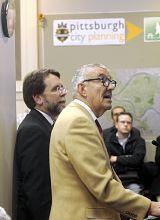
Fate of Civic Arena Debated

John Oyler, right, an engineer, talks Wednesday about how important the Civic Arena is as an example of structural engineering because it was done in the days before computer design. Speaking before the Historic Review Commission, he described how remarkable and unique the retractable dome is. Larry Roberts/Post-Gazette
To those who want to see it saved, the Civic Arena is an engineering marvel, an irreplaceable icon and a testament to Pittsburgh know-how.
But to those who want to see it go, the arena is “more a symbol of genocide” than a civic treasure, an aging relic with bad pipes, lousy acoustics and high maintenance costs.
So it went for more than four hours Wednesday during a public hearing before the Pittsburgh Historic Review Commission to determine whether the 49-year-old landmark should be designated as a city historic structure.
The commission, in a 5-1 vote last month, already gave preliminary approval to the designation, which would prevent the city-Allegheny Sports & Exhibition Authority from demolishing the building as part of a plan by the Pittsburgh Penguins to redevelop the site.
It is scheduled to take a final vote next month. Preliminary approval is no guarantee the arena will survive. In 2002, the panel gave similar approval to the designation only to reject it in a final vote.
Perhaps that’s the reason the nominator, Hill District resident Eloise McDonald, backed by Preservation Pittsburgh and Reuse the Igloo, and the SEA and the Penguins each spent more than an hour Wednesday advancing their arguments for or against designation.
Ms. McDonald and her allies believe the arena meets six of the 10 criteria that make a structure worthy of designation, including its location as a site for significant historic events, its exemplification of a rare, unique or innovative architectural style, and its unique location and distinctive physical appearance.
Only one of the 10 must be met to get a designation.
Franklin Toker, an architecture professor and the author of “Pittsburgh: A New Portrait,” argued that the arena “is, historically, the most representative building now standing in the city of Pittsburgh,” more so than the Cathedral of Learning, the county courthouse or the David L. Lawrence Convention Center.
He said the arena’s planning and construction “coincided exactly with the most exhilarating, most creative and most ambitious moment this city has ever known: the Pittsburgh renaissance.”
Others cited the arena’s retractable dome, one of the few in the world, or the engineering that made it work as reasons the old building should be saved.
Shawn Gallagher, the SEA’s attorney, said the agency doesn’t believe the arena meets even one of the 10 criteria for nomination.
He and others who support demolition said the arena requires millions of dollars in capital improvements, doesn’t meet accessibility standards and has no viable future as an entertainment venue.
“It clearly is not worthy of preservation,” Mr. Gallagher said.
City Councilman R. Daniel Lavelle said the arena, for many in the Hill, represents failed public policy, one that destroyed homes and businesses and displaced thousands of residents.
“This is not the sort of history we wish to preserve,” he said.
The hearing drew a number of other Hill residents who made similar comments, including former city Councilman Sala Udin, who said the arena is “more a symbol of genocide than a historic icon.”
And while some remember favorite concerts or exciting hockey games when they go into the arena, Hill resident Angela Howze recalls something else.
“Every time I go in there I remember it once was my grandmother’s house,” she said.
